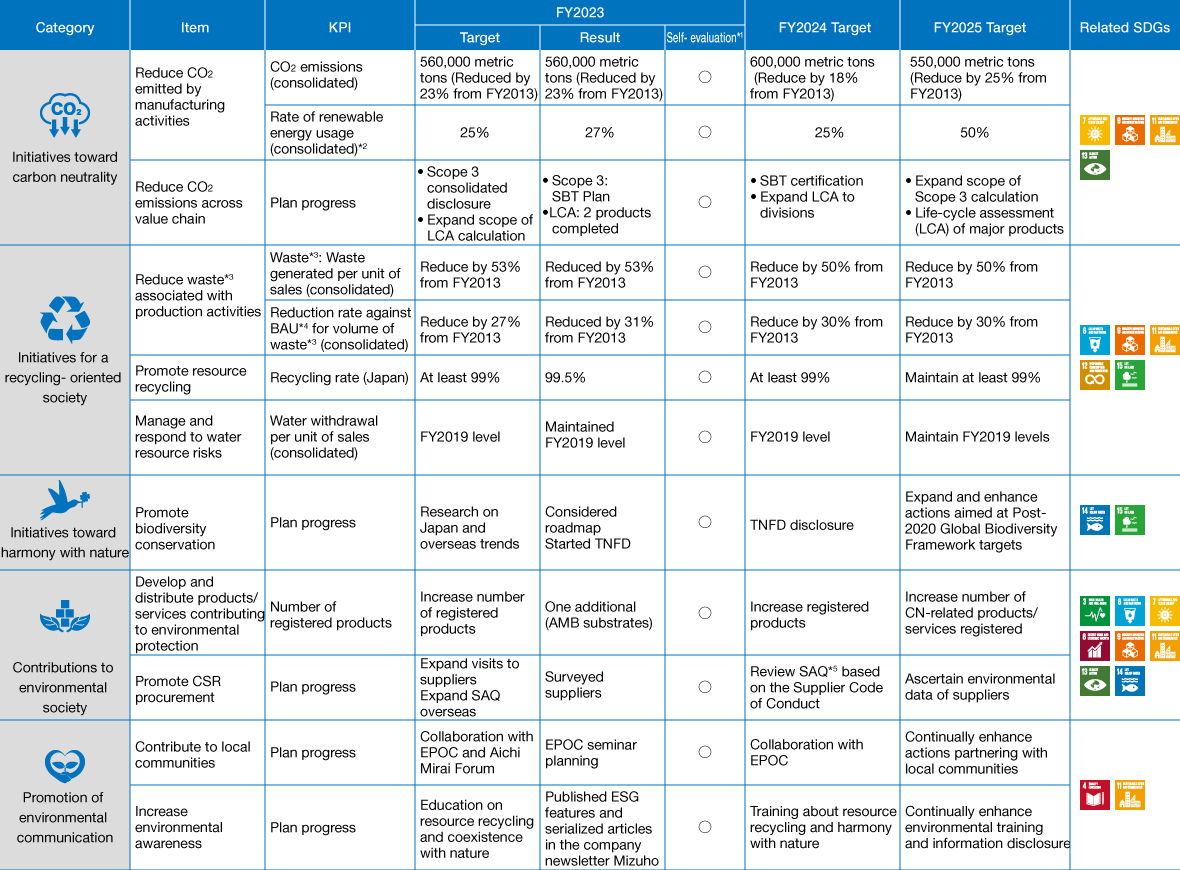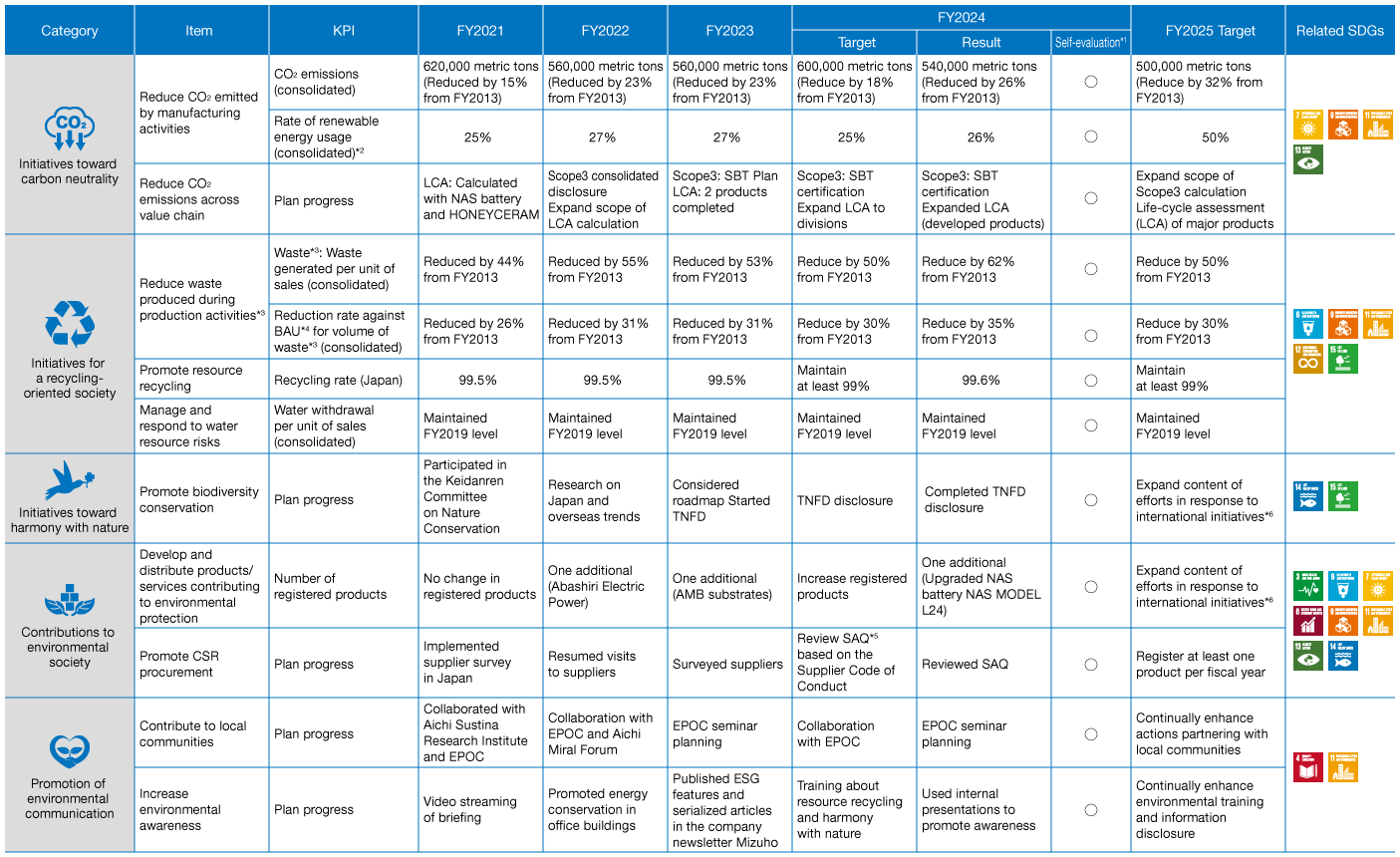Sustainability
Carbon Neutrality Strategic Roadmap and 5-Year Environmental Action Plan
Carbon Neutrality Strategic Roadmap
The NGK Group has drawn up its Carbon Neutrality Strategic Roadmap comprising four strategies as a guide to realizing the goals of the NGK Group Environmental Vision.
We have established a Group-wide target of net zero CO2 emissions by 2050, with milestone targets along the way of 500,000 metric tons by FY2025 (32% reduction compared with the FY2013 base year) and 370,000 metric tons by FY2030 (50% reduction). In the future, we will consider advancing our efforts to achieve net zero ahead of schedule by promoting the development of related technologies such as hydrogen, CCU and CCS (carbon capture, use and storage).
We set the target for FY2025 at 550,000 metric tons (25% reduction compared to the base year) when we first formulated the roadmap. However, we have revised that target to aim for a higher rate of reduction in CO2.
Four Strategies of the Carbon Neutrality Strategic Roadmap
Strategy 1: Development and provision of carbon neutrality (CN)-related products/services
In addition to our existing carbon neutrality (CN)-related products, we will also work to commercialize new products under development as well as offer society NAS battery-driven renewable energy supply business and other relevant services.
Strategy 2: Top-down enhancement of energy-saving
We will work to further enhance our existing energy conservation activities, as well as introduce high efficiency equipment and facilities and more energy-efficient operations.
Strategy 3: Promotion of technical innovation
Although the ceramics firing process requires fossil fuel which is responsible for CO2 emissions, we will work to switch over to hydrogen, ammonia and other fuels that will allow us to become fossil fuel-free.
Strategy 4: Expanded use of renewable energy
In addition to promoting various renewable energy procurement strategies both within Japan and overseas, we will install photovoltaic (PV) power generation systems at production sites within the NGK Group, and use them in conjunction with NAS batteries and zinc rechargeable batteries, to achieve demand control. We will use this as a model case in the NGK Group’s renewable energy business, and work towards the goal of enabling all energy demand within the NGK Group to be met through renewable energy.
Carbon Neutrality Strategic Roadmap

5th 5-Year Environmental Action Plan (FY2021–2025)
In FY2021, we established the fifth 5-Year Environmental Action Plan, which encompasses our environmental action targets through FY2025.
This is the first five-year plan aimed at realizing the NGK Group Environmental Vision announced in April 2021, which targets net zero CO2 emissions by 2050. We aim to achieve our Environmental Vision by focusing on its key themes of carbon neutrality, a recycling-oriented society, and harmony with nature.
Reference Year, Target Year, Control Scope
- Reference Year: FY2013 (for some, FY2019)
- Target Year: FY2025
- Control Scope: Consolidated (for some, Japan)
Below are the results to date of this 5-Year Action Plan, the targets and results for FY2024, and the targets for the final year of this plan, in FY2025.
We have made progress on efforts to promote energy conservation activities and to expand the use of renewable energy. In response to that, we have revised our target for CO2 emissions (consolidated) for FY2025 from the 550,000 metrics tons we initially set it at in 2021 to 500,000 metric tons.
- *1 Self-evaluation standards for achievement level of fiscal year target: ○: Target achieved; ×: Target not achieved
- *2 Ratio of electricity from renewable energy to total electricity consumption
- *3 Substances, including valuable substances, other than products that are discharged from business sites
- *4 Reduction rate compared to business as usual (the amount of waste generated if no improvements were made)
- *5 Self-Assessment Questionnaire concerning corporate social responsibility
- *6 We initially set the contents of our efforts based on the post-Aichi targets, but, with the adoption of the Kunming-Montreal Global Biodiversity Framework in 2022 and the subsequent transition to the new framework based on the international agreement, we have switched to using that framework
Results and Targets for the 5th 5-Year Environmental Action Plan
Results of the 5th 5-Year Environmental Action Plan in FY2024
We achieved all of our targets for FY2024.
We were able to achieve our target with our carbon neutrality efforts. We emitted 540,000 metric tons of CO2 in contrast to our target of 600,000 metric tons by promoting energy conservation activities, expanding the use of renewable energy and taking other measures. In addition, the rate of the power we used derived from renewable energy was 26%. Thus, we also achieved this target.
We achieved our quantitative targets for the reduction of waste and the management of water withdrawal in our efforts toward a recycling-oriented society.
In terms of harmony with nature, we promoted an expansion in the content of our disclosures based on the Taskforce on Nature-related Financial Disclosures (TNFD). Furthermore, we newly registered a new NAS battery (NAS MODEL L24) as a product that contributes to the environment in our contributions to environmental society.
We contributed to local communities and raised environmental awareness by holding seminars with the Environmental Partnership Organizing Club (EPOC) and using in-house presentation meetings to promote environmental communication.

